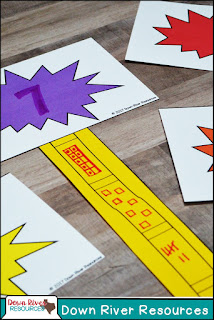Read Across America Week, Springtime, and Earth Day are all soon approaching... too fast for my liking! Dr. Seuss' fun truffela trees make the perfect math center for kindergarten and first grade students. By this time of year, kindergarten students should have a grasp of the first 10 or 15 numbers. Students should be quickly working towards knowing their numbers up to 20 by the end of the year. First grade students with number sense have met this goal before, but diverse students may still be working towards achieving that goal. This fun math center will provide you the opportunity to practice building number sense in your students during these spring months or whenever you feel "Seuss-ical!"
Using the Lorax in a Fun Math Center
Dr. Seuss' The Lorax is a fictional children's book that was published in 1971. The passionate orange fella, also the main character, the Lorax, speaks for the trees against the antagonist, the Once-ler. The Once-ler tells a tale of the beautiful valley containing a forest of Truffula trees, a whimsical organism, and a range of animals. He paints such a beautiful picture, but it was he who destroys it for greed. He uses the plant to create a material at the large factory.
The Lorax is a really great story for students to be introduced to environmental science. It is a popular picture book to read for Earth Day too! This tree that once towered over the animals has been brought to life in their own unique way, as fluffy flowers. They stand tall and are quite magical as they help students read and recognize numbers to 20.
Incorporating Science Vocabulary through Math Center
I love calling the pieces of this math puzzle by their correct name too. I use the word "flower" to describe the tops or starburst looking pieces. "Stem" or "trunk" can be used for the bases which three representations of each number are found including: ten frames, tally marks, and base-10 cubes.
It is the students' task to put together the fluffy flowers with the correct pieces, matching the numeral to the representations.

Prepping the math center can be as easy or difficult as you'd like it to be. The EASIEST way is to keep the rectangular shapes around the flowers and stems, so you do not have to spend an hour cutting out around the jagged edges.
As you can imagine, the most difficult way to prepare this math center is by cutting out the flowers and stems. While it does give this center A LOT of pizzazz, it is time consuming.
Let's face it, you might not have time for that. ;)

Diverse Ways to Prepare this Rigorous Resource
As you can imagine, the most difficult way to prepare this math center is by cutting out the flowers and stems. While it does give this center A LOT of pizzazz, it is time consuming.
Let's face it, you might not have time for that. ;)
 You've probably noticed through the photographs you can print with an ink-saving option (black line) or full color, if you happen to have an ink fairy at your school...I'm not so lucky.
You've probably noticed through the photographs you can print with an ink-saving option (black line) or full color, if you happen to have an ink fairy at your school...I'm not so lucky.Now, friends, this is probably the feature I looooove the best! It is perfect as a challenge in kindergarten and gives a differentiation option to first and, even, second grades.
There is a set of blank templates. THE STUDENTS fill them out and create their own. In kindergarten, they'd probably follow the same format. In first grades, students can write larger numbers up to 120, while in second grades students can use numbers up to 1,200.
Can you imagine using this option and each kiddo making one? I think that would be a cute bulletin board display!
In fact, I'm off to prepare for that now!
I hope this post inspires you to be creative this spring in your math centers and if you'd like to use my fluffy flowers number puzzles, you can find them in my TpT shop.
What are some ways that integrate math math during these fun spring holidays?







No comments